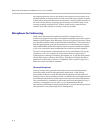
Designing Audio Conferencing Systems
B - 5
audio signal. When this happens, a noticeable beeping or chipping sound that
sounds modulated such as if it were Morse code, will be heard at the remote
locations.
If this problem is present, the solutions are to move cellular telephones away
from the microphones, turn off cellular telephones, or to use microphones that
have improved noise immunity to these high frequencies. Many
manufacturers are now producing microphones with improved noise
immunity.
Boundary Microphones
Boundary microphones use the surface the microphone is installed on and the
proximity of the microphone element to the boundary surface to minimize the
amount of phase cancellation that occurs when audio strikes the boundary.
The resulting microphone configuration has a higher sensitivity. The pick-up
pattern of the microphone will become half-spherical as the sounds below the
boundary are not picked up. For instance if an omni-directional microphone
is placed on a boundary, the pattern becomes semi-spherical. A cardioid
microphone placed on a boundary will become a semi-cardioid pattern with
the sound below the boundary not picked up by the microphone.
Critical Distance
For every audio source in a room there is a distance from that source, called
the critical distance, where the reverberant sound field and the direct sound
field from the source are equal in intensity. If a microphone is placed farther
than the critical distance away from the source, typically a local talker, the
resulting speech quality will be considered very poor - characterized by a
bottom-of-the-barrel or muffled sound. The critical distance is a function of
both the physical distance from the local talker to the microphone, the
directionality of the source, and the liveliness of the acoustics in the room.
More reverberant rooms will have a shorter critical distance which
underscores the requirement to place microphones as close to the talkers as
possible. Increasing the gain on a microphone will not help reduce the critical
distance as the reverberation and noise will be amplified along with the local
talker's voice when the gain is increased.
The critical distance can be measured with an SPL meter and noise source.
When the measured sound level doesn't drop by 4 to 6 dB for each doubling of
the distance, the critical distance of the microphone from the noise source has
been reached.
As a rule of thumb, for omni-directional microphones, the microphone should
be no farther than 30% of the critical distance away from the talker. A
directional microphone should be placed no farther than 50% of the critical
distance.
If due to architectural constraints, or room usage requirements, the
microphones must be placed farther than 50% of the critical distance (for
instance with ceiling microphone installations), the users must either accept
the resulting speech quality or increase the effective critical distance by


















